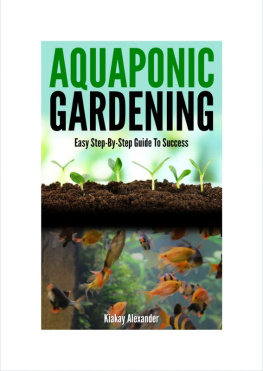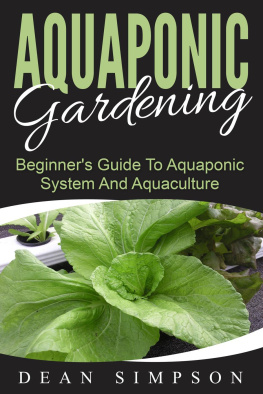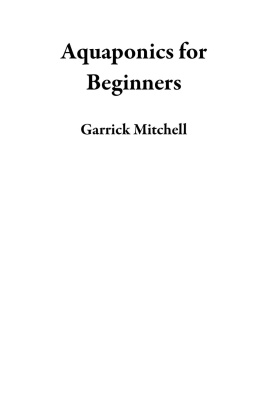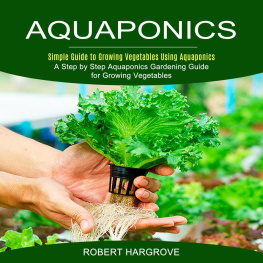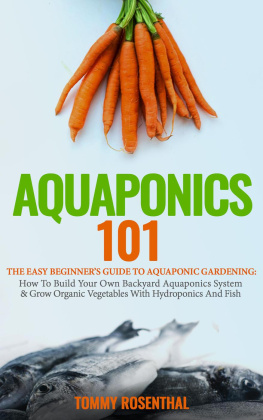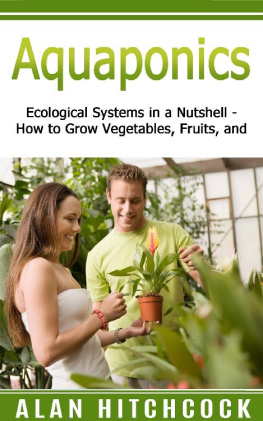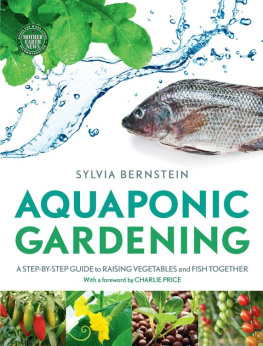AQUAPONIC GARDENING
by
Kiakay Alexander
Copyright 2013 Kiakay Alexander
Smashwords Edition, License Notes
This ebook is licensed for your personal enjoymentonly. This ebook may not be re-sold or given away to other people.If you would like to share this book with another person, pleasepurchase an additional copy for each recipient. If youre readingthis book and did not purchase it, or it was not purchased for youruse only, then please return to Smashwords.com and purchase yourown copy. Thank you for respecting the hard work of thisauthor.
DISCLAIMER
All rights reserved.
The entire rights of the content found inthis eBook are reserved with the publisher. The replication orrepublication of any part of this book in any form, or by any mean,electronic, mechanical, photocopied, recorded, scanned orotherwise, is strictly prohibited without getting the consent fromthe author of the book. Any such action that comes to the notice ofpublisher is punishable by law.
The author of the book does not contradictany other information found about the subject of this book on anyother source. This e-book is solely for educational purposes andshould be taken as such. The author takes no responsibility for anymisappropriation of the contents stated in this e-book and thuscannot and will not be held liable for any damages incurred becauseof it.
While the author of this book has made utmostefforts to obtain updated and accurate information containedherein, the author or the publisher of the book cannot be heldliable for any damage or loss caused by the content of this book.The author of the book does not warranty the accuracy of thecontents and disclaim all warranties with respect to theinformation contained herein, its accuracy and applications.
The author cannot be held responsible for anypersonal or commercial damage caused by misinterpretation ofinformation. All readers are encouraged to seek professional advicewhen needed.
The author of the book does not endorse anyperson of whom the quotations have been used in this book. Neitherthe author nor publisher of the book takes any credits for thecited quotations.
Individual Results may vary.
QUICK VIEW OF THE GUIDE
The fact that you are sparing time to readthis book is proof enough of your interest in gardening. Or is itjust that the increasing popularity of aquaponic gardening havemade you curious about it? Well in either case, you have landed onthe right land.
From the basics of Aquaponics to the step bystep procedure, maintenance and troubleshooting; this book tellsyou all you need to know about Aquaponic gardening.
While in simple terms aquaponic gardening isthe amalgamation of raising fish and soil-less gardening, thisrevolutionary form of gardening is much more then this simpledefinition. However, it is not difficult to make and maintain anaquaponic garden once you know the right procedure and rules.
This book intends to do that for you. Fromthe planning of an aquaponic garden to its successful maintenanceand growth, this guide will serve as your companion throughout yourjourney of aquaponic gardening.
Moreover, the benefits of aquaponic gardeningthat are explained in detail in the upcoming chapters aredefinitely worth the little efforts that you would have to putthrough while learning about it. This book intends to make thisjourney easy, fun and exciting for you.
So dont just stop here. Continue reading andexperience gardening of your lifetime.
TABLE OF CONTENTS
Introduction
Why Aquaponic Gardening ?
Potential Of Aquaponic Gardening
System Location Considerations
Hardware Components
The Living Components
Putting It All Together
Starting And Maintaining A Healthy System
Aquaponics Troubleshooting
Final Words
INTRODUCTION
While it gained immense attention in the pastfew years, aquaponics is not as new as it is thought to be. As amatter of fact, it is a very ancient phenomenon. The history ofaquaponics can be traced back to 1,000 A.D. when the Aztec Indiansused to grow plants on rafts floating in the lake. In that era,aquaponics was popular because it reduced the farmers dependenceon land, soil and other resources. Nowadays, its increasingpopularity can be attributed to the increasing awareness and healthconsciousness in people.
The most attractive feature of aquaponics isthat it can be used to grow plants and breed fish at any scale.Whether you intend to do it on a large commercial scale or startwith a small aquaponic system in your house; the rules, conceptsand basic resources remains the same.
Patience and proper knowhow are two mostimportant requirements to run an aquaponic system. While youyourself will have to work on the first requirement, the latter isaddressed in this book.
In its simplest form, Aquaponics is a farmingsystem that blends hydroponics (soil less planting) and aquaculture(fish farming). But this is just not it. Aquaponics is much morevast and comprehensive then this mere definition.
To understand it more clearly, it isimportant to know about the two terms that made aquaponics:
Term 1: Hydroponics
Hydroponics is a farming technique forgrowing plants without soil. The literal meaning of the termhydroponics is working water. It implies the cultivation ofplants using water and certain other chemical components. Being theprimary component in soil-less farming, the water used inhydroponics is highly oxygenated and chemical rich.
Hydroponics has several advantages over thetraditional farming technique.
No soil is required in hydroponic gardening.
You do not require large farming land. Hydroponicscan be performed even in your own house.
Since the plant grows in water, you do not have toworry about watering.
Less amount of water is lost in evaporation.
It is comparatively easier to harvest plants in ahydroponic system.
It saves you from the hassles of weeding, mulchingand soil changing.
It is exposed to reduced risk of insect attack.
While there are several advantages of hydroponics,certain drawbacks are also associated with it.
The chemical nutrients needed to enrich the water arecostly.
Water in the hydroponic system needs to be replacedperiodically. Since the water is chemical-rich, its disposal isnot so easy.
Hydroponics is man-made and therefore lessorganic.
The hydroponic system is vulnerable to water bornediseases
The best part here is that thesedisadvantages are addressed and taken care of in the aquaponicssystem.
Term 2: AquaCulture
Aquaculture can be defined as the process ofdeveloping and maintaining a culture of aquatic animals and plants.In other words, it refers to the cultivation of animals and plantsin water. Aquaculture is not only restricted to fresh water butalso includes saltwater plants and animals.
The history of aquaculture dates back to the5th century B.C. when the Chinese fisherman used to catch youngfish from the sea and then raise them in an artificial environment.This simple aquaculture process has now advanced up to the modernre-circulating aquaculture system (RAS), where the aquatic animalsand plants are raised in tanks.
The best thing about RAS systems is that theycan be developed and maintained anywhere and on any scale. However,RAS is capital intensive, costly and highly dependent uponelectricity for providing aeration to the fish. Another majordisadvantage of aquaculture is in terms of the fish waste anddisposal process. Fish produce solid waste and ammonia. This alongwith the uneaten food that sinks to the bottom of the tank pollutesthe water.
Just like hydroponics, the disadvantages ofaquaculture are taken care of in an aquaponic system.
Next page
